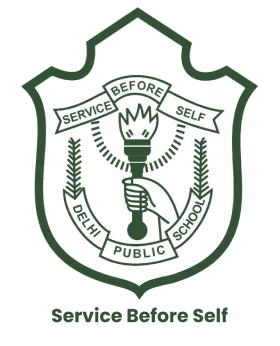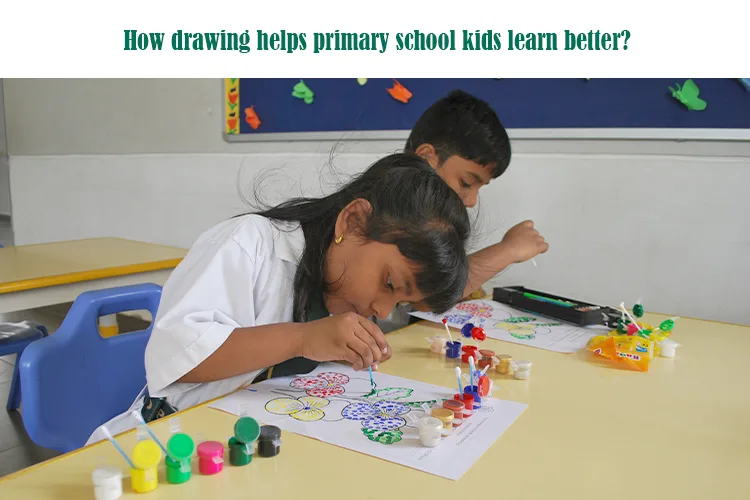Us humans seldom struggle to show emotions and say the right words. As a grown up, we can only wonder how hard it is for our kids. Letting him/her draw their heart out can be a great start! Learning to draw is a bridge to a child’s creativity.
Youngsters’ drawings appear to be scribbles and scratches at the start. And it does not get better for those who struggle with art! However, Education drawing has many advantages other than creating art. Adding to its social and emotional benefits of drawing also adds value to children’s cognitive development. At DPS Warangal, the best CBSE school, we take drawing very seriously for our students.
One advantage of creative learning to draw for kids in the classroom is that it helps a kid write neatly over time. When young children start writing, they first hold a fat crayon and work their way to make a proper pincer grip. Children then draw random lines, dots, and swirls, which boosts a child’s hand-eye coordination. When students partake in a draw and learn scenario, they are seen to have more interest in learning. Continue scrolling to read more about how kids draw and learn in education and fun drawing activities for kids.
What is drawing for primary kids in school?
Drawings make things easy for human minds to understand. Education drawing helps create visual models in our memory that help us understand difficult ideas. Schools place high value on draw and learn at an early age for these reasons. Students are seen to learn and retain information better when they draw.
According to international studies, the benefits of drawing helps students remember 50–80% more information. Education drawing boosts memory as well as problem-solving skills.
Creative learning to draw for kids is extremely important in education because it allows students to express themselves in non-traditional ways. Education drawing boosts unconventional thinking in the 21st-century where skill-based creative learning is given great importance. It’s also a safe way for children to communicate feelings and emotions without worrying about criticism!
Since kids are allowed to draw and learn anything they want, drawing builds children’s imagination and creativity. As kids concentrate on what they’re making, the benefits of drawing include sketching as a great mindfulness exercise that helps them focus. Sketching and painting are great drawing activities for kids.
Benefits of drawing in primary school
- Increases focus and concentration
Students build focus when they work on art tasks. The benefit of drawing is that it asks for patience and attention to detail. The commitment needed to draw increases students’ focus and helps their academic life. For example, think about drawing activities for kids, like a student sketching their pet dog for an hour. Students notice small details as they draw the dog’s fur or eyes. Students keep fixing the drawing till it looks perfect to them. The patience and concentration are carried to academics as they learn to draw for kids, and now they can sit through long readings as they are already used to it while sketching. - Enhances retention and memory
Art improves memory and retention by stimulating important brain regions. According to studies, students who participate in drawing activities for kids do better in academic studies because they better retain information. Think of a student participating in creative learning about ancient Egypt in history class. To remember important notes, the students draw and learn a colorful timeline with important years and facts or diagrams of how pyramids used to look. Later, during a quiz, they will remember dates and facts because the drawing activities for kids lock the information in their memory. The same can be done for any subject like science, geography, maths and more. This is why creative learning to draw for kids is good for them. - Improves eye-hand coordination
As children use crayons or pencils, they improve their hand-eye coordination and muscle control. Take the example of a student drawing geometric shapes for a class assignment. It automatically builds hand-eye coordination as benefits of drawing when they draw each line to make an image. Besides becoming better at art, drawing and learning improves accuracy in other areas. Such as writing neatly or participating in sports like basketball, which require very strong hand-eye coordination. - Early cognitive development
Creative learning to draw for kids can improve cognitive development in young kids aged ten to thirteen. Education drawing is a good exercise because it teaches spatial awareness to kids. Imagine a student drawing their classroom from memory, including desks, windows, and where their friends sit. This kid is working on understanding spatial awareness the moment he/she thinks about where each item is placed and how big or small it should look on paper. Hence, Education drawing helps them learn how to observe details and organize thoughts. - Expression of oneself
Kids communicate and tell stories through drawing, which helps in language development and self-expression. Imagine a 13-year-old student drawing a comic strip about a superhero. They creatively convey their feelings through their drawings. Along with emotional growth, it also makes them proficient in language and storytelling. Parents should motivate creative learning to draw for kids.
How to teach drawing to primary kids step by step?
Kids are naturally curious and creative. There are a number of drawing activities for kids that parents and teachers can suggest. Below are the ways you can help in creative learning to draw for kids step by step and make them understand about benefits of drawing:
- Begin with the fundamentals.
Children should be taught the fundamental shapes and how to draw and learn them. Next, proceed to basic objects such as trees, houses, and animals. As you begin with the basics, be sure to
- Help them get creative if they run into a block. “Let’s draw eyes, nose and ears to the tree to make it look funny!” will make them use their imagination and help them learn to draw for kids.
- Let kids make mistakes and keep trying. Making mistakes is a necessary part of their improvement as artists.
- Make it enjoyable by turning education drawing into stories or adding goofy details.
- Use many types of stationary
Play with markers, chalk, paint, crayons, colored pencils, and pencils! This practice will maintain their attention and allow them to experiment with various hues and textures.
When using various media, remember to:
- Motivate them to draw and learn any shape or use any color they want. No color or shape is “wrong” in education drawing, so allow experimenting.
- Let them get messy. It’s okay if they get paint on their clothes or chalk on the floor since this is how young kids learn.
- Test with various surfaces to draw on
Try drawing on cardboard, cardstock, butcher paper, construction paper, and even fabric in addition to regular paper. As a result, they will have the opportunity to use new materials and understand textures when practicing the benefits of drawing.When using various surfaces, keep in mind to:
- Question them, “What can you make with this piece of cardboard?” or “How can we create an artwork out of this fabric?”. Questions like these will boost a kid’s imagination.
- If they’re at a loss, guide them by giving ideas for material uses.
- Get kids excited about drawing
Include movement in your drawing exercises to help kids have fun and release pent-up energy! Here are a few suggestions:
- Hold a drawing competition. See who can draw the line the longest or the fastest.
- Turn it into a game. Instead of using words, use drawings to play Simon Says or “I Spy.”
- Work together, have your child draw and learn a picture and add to it, or vice versa.
Art education is a good way to help kids grow emotional intelligence and do well in academics. A Kid’s artistic expression is a solid base for building new bonds, taking wise decisions and scoring great marks.
To develop well-rounded people, DPS Warangal, the best day & boarding school in Warangal Telangana, inculcates art education into the CBSE curriculum of our primary class students. By motivating art education, our students have a new love for creative learning and creativity. Since we know the benefits of drawing in students’ academic performance, we help our students work on their valuable skills that boost their education.


